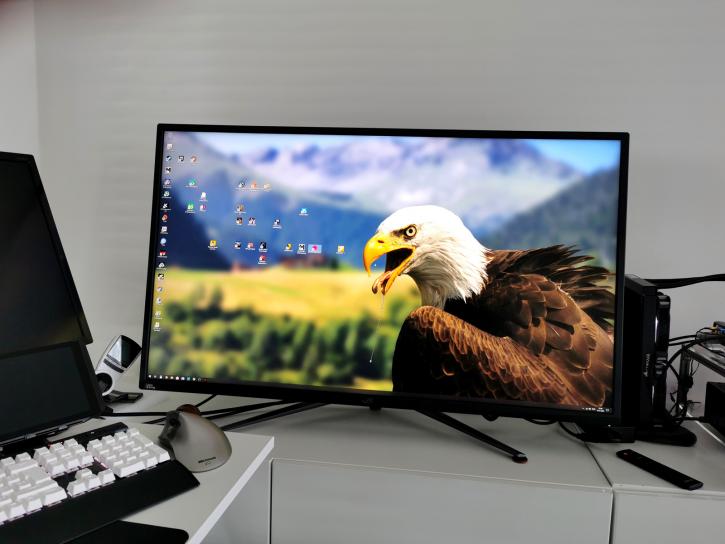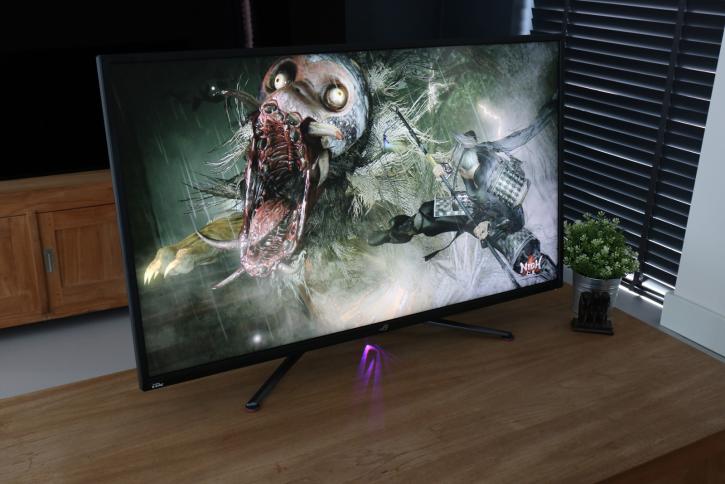Features and technology
ROG Swift PG43UQ
The ROG Swift PG43UQ is the among the first monitors to run 4K UHD (3840 x 2160) content at a 144Hz refresh rate, providing gamers with detailed ultra-high definition visuals at smooth frame rates. New for the PG43UQ is also a feature called HDR Max, allowing users to limit the panel’s maximum brightness to 400, 600 or 1000 cd/m2. The panel is VA, delivering a typical contrast ratio of 4000:1, and comes coated with a matte, non-glare surface.
Built around a 43” WLED VA panel utilizing Display Stream Compression (DSC), allowing for a maximum refresh rate of 144Hz at a 4K (3840x2160) resolution over a single DisplayPort cable. This solution allows full compatibility with variable refresh rate technologies as well as HDR capabilities without perceptible loss of image quality or added processing times. With its 144Hz maximum refresh rate high-paced gameplay will appear buttery smooth and added to that is a 1ms (MPRT) response time essentially eliminating blur, leaving any TV sets on the market hard pressed to match its feature set for gaming. It sports G-Sync Compatible as well as Adaptive-Sync (FreeSync) badges, allowing for dynamic synchronization in the 48-144Hz range. Impressive audio, we need to mention that - the PG43UQ arguably offers really good audio, a 2x10W sound system. It also offers a Picture-by-Picture mode and comes with a remote for quick adjustments of all these parameters and more in scenarios where the monitor is at more than an arm’s length away.
The ROG Swift PG43UQ’s 10-bit, VESA DisplayHDR 1000 certified panel reproduces 90% of the DCI-P3 (125% of sRGB) color space, while allowing for peak brightness levels of a 1000cd/m2. With support for cinema-standard DCI-P3 color gamut, you retrieve a 25% wider color range than sRGB, resulting in more realistic color reproduction. From an aesthetic appearance, this monitor ticks all the right boxes for any true PC gamer (apart from its massive size). The design is lovely to look at from a visual perspective, mostly due to its size but also due to its ROG styling. It's a sturdy product as well, and it sits on your desktop or game room like a serious looking bloke.
Quad HD versus Ultra HD
Some will not be too pleased about this paragraph I expect, but it is my vision - the crisp details that 4K resolutions offer is not debatable, at 24 up-to 30 inches, you can, however, question the validity of that choice given the screen size and pixel density you're looking at. See, the number of pixels (almost 8.3 million pixels) for Ultra HD comes with certain disadvantages as not all software can scale very well, and on all displays smaller than 32 inches, and even at 32 inches, at least 125% scaling is often mandatory with Ultra HD. When scaling works well, heck, that is not an issue, however, there are still a lot of applications that run into problems being displayed too small. There is another disadvantage with Ultra HD, and that's game performance.
For the ROG Swift PG43UQ a 4K screen is absolutely spot on, thanks to it's 43" size, the pixel density is simply put spot on. Ultra HD comes with consequences though, 8 million pixels that need to be refreshed 144 times per second on this screen. To date few graphics cards can deal with that and, as such, it requires deep pocket investments to be made. With a choice of Ultra HD gaming, a large amount of graphics computing power is mandatory. The bottom line here is that Ultra HD gaming is an expensive hobby. Up-to that 30- or 32-inch range, the more logical and affordable solution is to go with something like a Quad HD panel at 2560x1440 or 3440x1440. Passing 32-inches we can recommend an Ultra HD screen. So for the ROG Swift PG43UQ, this is spot on.
HDR on the ROG Swift PG43UQ
The HDR implementation on this monitor is pretty good really. Playing HDR games like Far Cry New Dawn, FF15 and Formula 1 exhibited a level of clarity that not something that is easily described in a review. Seeing it in a real-world environment, in the end, is what will be the convincing factor. The monitor is both VESA DisplayHDR 1000 and Ultra HD Premium certified to ensure a proper HDR viewing experience. My advice, go to a store, watch HDR and let yourself be convinced. It's more and dynamic colors, retina soaring whites. You'll notice it in-game with fires, car headlights, the sun or moon. It is just awesome to watch, however for some also can be a bit too much as a 1000 nits, trust me it a lot on the eyes and completely different experience compared to SDR gaming.



